2016 Hyundai Grand Santa Fe engine
[x] Cancel search: enginePage 552 of 717
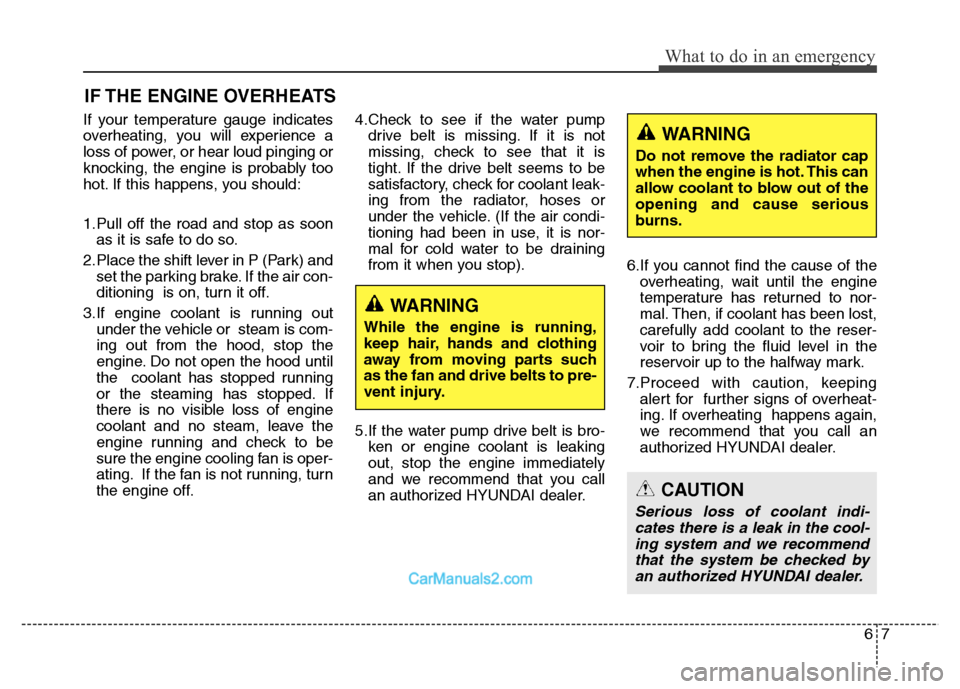
67
What to do in an emergency
IF THE ENGINE OVERHEATS
If your temperature gauge indicates
overheating, you will experience a
loss of power, or hear loud pinging or
knocking, the engine is probably too
hot. If this happens, you should:
1.Pull off the road and stop as soon
as it is safe to do so.
2.Place the shift lever in P (Park) and
set the parking brake. If the air con-
ditioning is on, turn it off.
3.If engine coolant is running out
under the vehicle or steam is com-
ing out from the hood, stop the
engine. Do not open the hood until
the coolant has stopped running
or the steaming has stopped. If
there is no visible loss of engine
coolant and no steam, leave the
engine running and check to be
sure the engine cooling fan is oper-
ating. If the fan is not running, turn
the engine off.4.Check to see if the water pump
drive belt is missing. If it is not
missing, check to see that it is
tight. If the drive belt seems to be
satisfactory, check for coolant leak-
ing from the radiator, hoses or
under the vehicle. (If the air condi-
tioning had been in use, it is nor-
mal for cold water to be draining
from it when you stop).
5.If the water pump drive belt is bro-
ken or engine coolant is leaking
out, stop the engine immediately
and we recommend that you call
an authorized HYUNDAI dealer.6.If you cannot find the cause of the
overheating, wait until the engine
temperature has returned to nor-
mal. Then, if coolant has been lost,
carefully add coolant to the reser-
voir to bring the fluid level in the
reservoir up to the halfway mark.
7.Proceed with caution, keeping
alert for further signs of overheat-
ing. If overheating happens again,
we recommend that you call an
authorized HYUNDAI dealer.
CAUTION
Serious loss of coolant indi-
cates there is a leak in the cool-
ing system and we recommend
that the system be checked by
an authorized HYUNDAI dealer.
WARNING
While the engine is running,
keep hair, hands and clothing
away from moving parts such
as the fan and drive belts to pre-
vent injury.
WARNING
Do not remove the radiator cap
when the engine is hot. This can
allow coolant to blow out of the
opening and cause serious
burns.
Page 554 of 717
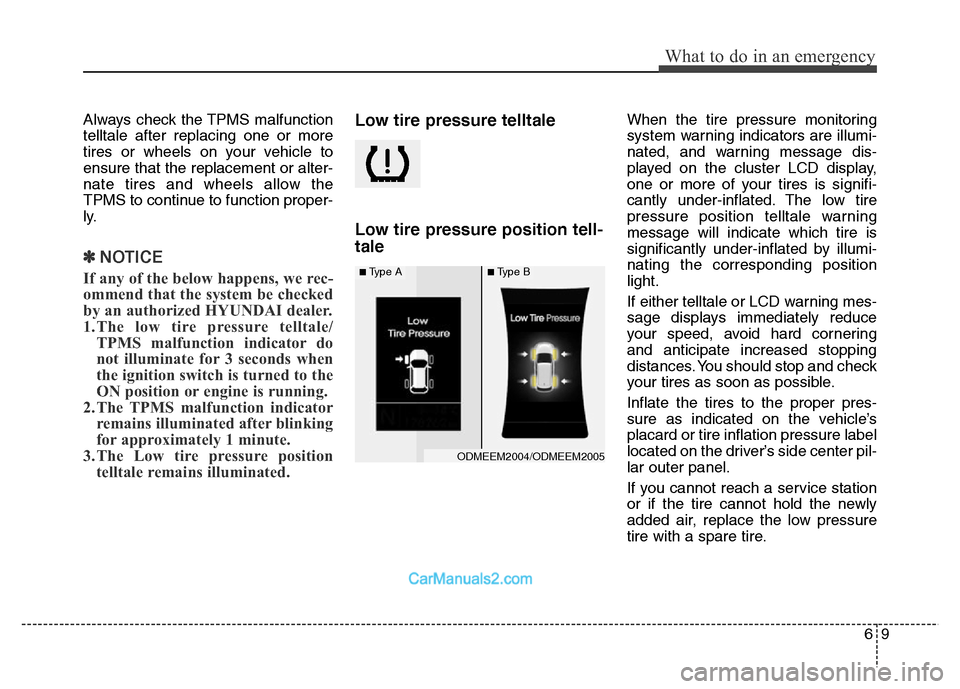
69
What to do in an emergency
Always check the TPMS malfunction
telltale after replacing one or more
tires or wheels on your vehicle to
ensure that the replacement or alter-
nate tires and wheels allow the
TPMS to continue to function proper-
ly.
✽NOTICE
If any of the below happens, we rec-
ommend that the system be checked
by an authorized HYUNDAI dealer.
1.The low tire pressure telltale/
TPMS malfunction indicator do
not illuminate for 3 seconds when
the ignition switch is turned to the
ON position or engine is running.
2. The TPMS malfunction indicator
remains illuminated after blinking
for approximately 1 minute.
3. The Low tire pressure position
telltale remains illuminated.
Low tire pressure telltale
Low tire pressure position tell-
taleWhen the tire pressure monitoring
system warning indicators are illumi-
nated, and warning message dis-
played on the cluster LCD display,
one or more of your tires is signifi-
cantly under-inflated. The low tire
pressure position telltale warning
message will indicate which tire is
significantly under-inflated by illumi-
nating the corresponding position
light.
If either telltale or LCD warning mes-
sage displays immediately reduce
your speed, avoid hard cornering
and anticipate increased stopping
distances. You should stop and check
your tires as soon as possible.
Inflate the tires to the proper pres-
sure as indicated on the vehicle’s
placard or tire inflation pressure label
located on the driver’s side center pil-
lar outer panel.
If you cannot reach a service station
or if the tire cannot hold the newly
added air, replace the low pressure
tire with a spare tire.
ODMEEM2004/ODMEEM2005
■Type A■Type B
Page 560 of 717
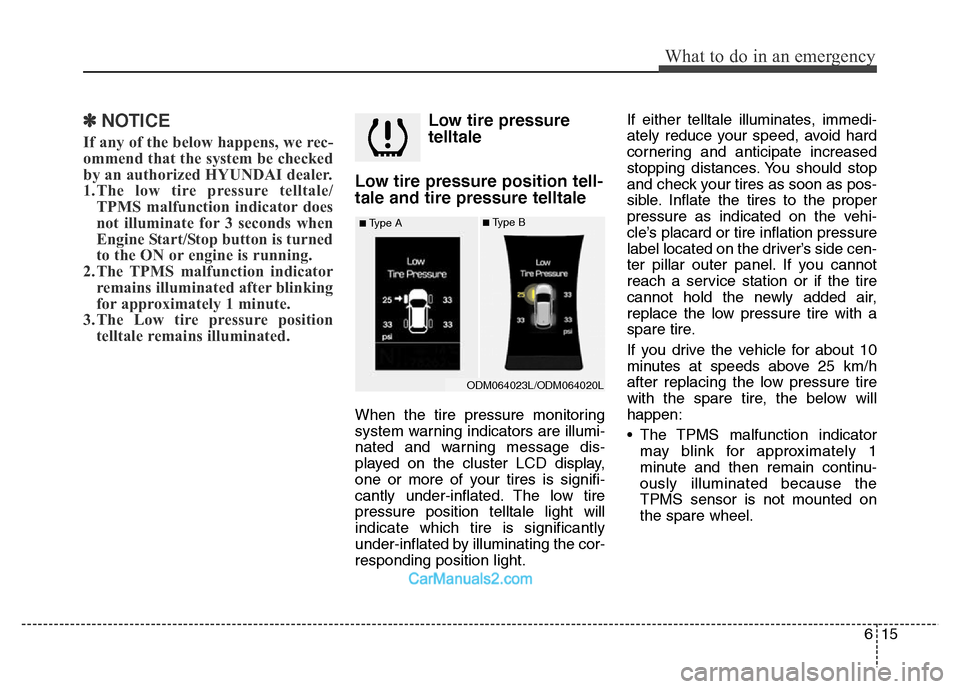
615
What to do in an emergency
✽NOTICE
If any of the below happens, we rec-
ommend that the system be checked
by an authorized HYUNDAI dealer.
1.The low tire pressure telltale/
TPMS malfunction indicator does
not illuminate for 3 seconds when
Engine Start/Stop button is turned
to the ON or engine is running.
2. The TPMS malfunction indicator
remains illuminated after blinking
for approximately 1 minute.
3. The Low tire pressure position
telltale remains illuminated.
Low tire pressure
telltale
Low tire pressure position tell-
tale and tire pressure telltale
When the tire pressure monitoring
system warning indicators are illumi-
nated and warning message dis-
played on the cluster LCD display,
one or more of your tires is signifi-
cantly under-inflated. The low tire
pressure position telltale light will
indicate which tire is significantly
under-inflated by illuminating the cor-
responding position light.If either telltale illuminates, immedi-
ately reduce your speed, avoid hard
cornering and anticipate increased
stopping distances. You should stop
and check your tires as soon as pos-
sible. Inflate the tires to the proper
pressure as indicated on the vehi-
cle’s placard or tire inflation pressure
label located on the driver’s side cen-
ter pillar outer panel. If you cannot
reach a service station or if the tire
cannot hold the newly added air,
replace the low pressure tire with a
spare tire.
If you drive the vehicle for about 10
minutes at speeds above 25 km/h
after replacing the low pressure tire
with the spare tire, the below will
happen:
• The TPMS malfunction indicator
may blink for approximately 1
minute and then remain continu-
ously illuminated because the
TPMS sensor is not mounted on
the spare wheel.
ODM064023L/ODM064020L
■Type A■Type B
Page 566 of 717

621
What to do in an emergency
Removing and storing the
spare tire
Your spare tire is stored underneath
your vehicle, directly below the cargo
area.
To remove the spare tire:
1.Open the tailgate.
2.Find the plastic hex bolt cover and
remove the cover with coin or flat -
blade screwdriver.3.Use the wheel lug nut wrench to
loosen the bolt enough to lower the
spare tire.
Turn the wrench counterclockwise
until the spare tire reaches the
ground.
ONCDEM2001
(Continued)
• The vehicle can easily roll off
the jack causing serious
injury or death.
• Do not get under a vehicle
that is supported by a jack.
• Do not start or run the engine
while the vehicle is on the
jack.
• Do not allow anyone to remain
in the vehicle while it is on the
jack.
• Make sure any children pres-
ent are in a secure place away
from the road and from the
vehicle to be raised with the
jack.
ONCNEM2002
Page 574 of 717
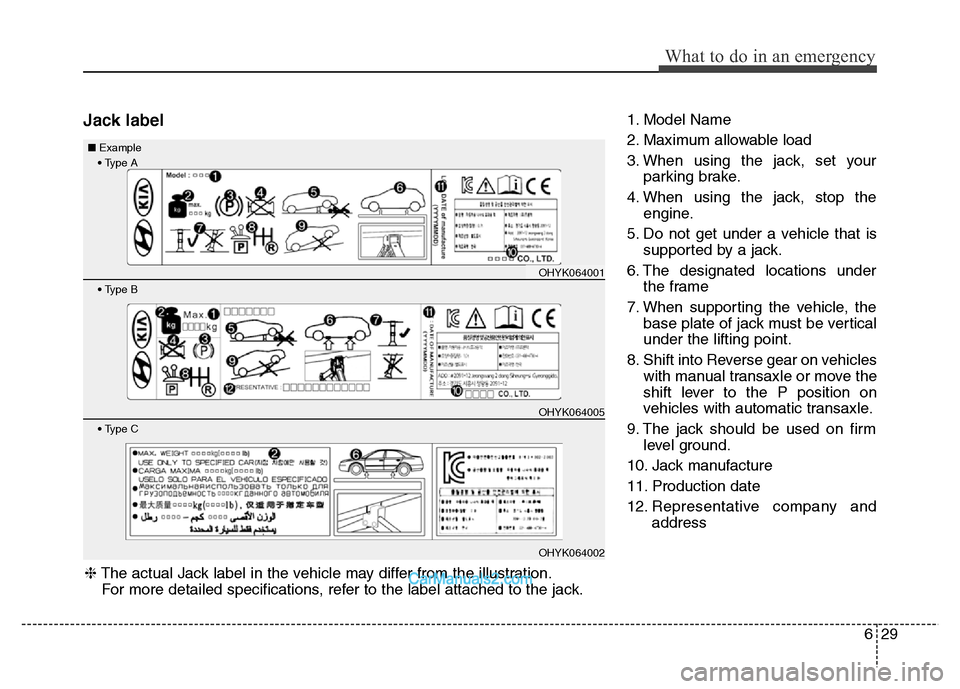
629
What to do in an emergency
Jack label1. Model Name
2. Maximum allowable load
3. When using the jack, set your
parking brake.
4. When using the jack, stop the
engine.
5. Do not get under a vehicle that is
supported by a jack.
6. The designated locations under
the frame
7. When supporting the vehicle, the
base plate of jack must be vertical
under the lifting point.
8. Shift into Reverse gear on vehicles
with manual transaxle or move the
shift lever to the P position on
vehicles with automatic transaxle.
9. The jack should be used on firm
level ground.
10. Jack manufacture
11. Production date
12. Representative company and
address
❈The actual Jack label in the vehicle may differ from the illustration.
For more detailed specifications, refer to the label attached to the jack.
• Type A ■Example
• Type B
• Type C
OHYK064001
OHYK064005
OHYK064002
Page 582 of 717
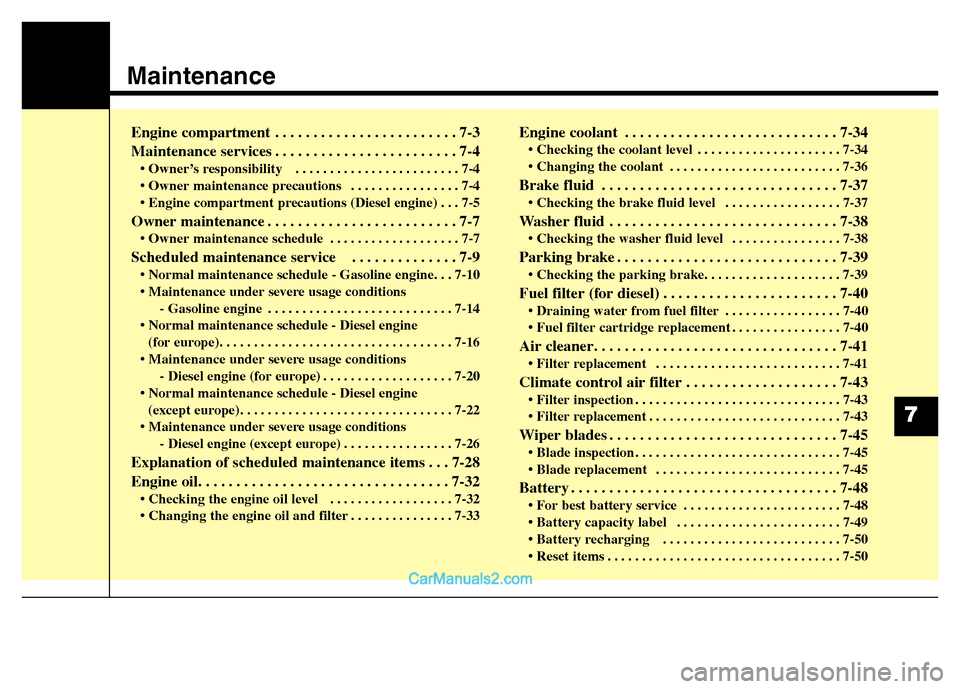
Maintenance
Engine compartment . . . . . . . . . . . . . . . . . . . . . . . . 7-3
Maintenance services . . . . . . . . . . . . . . . . . . . . . . . . 7-4
• Owner’s responsibility . . . . . . . . . . . . . . . . . . . . . . . . 7-4
• Owner maintenance precautions . . . . . . . . . . . . . . . . 7-4
• Engine compartment precautions (Diesel engine) . . . 7-5
Owner maintenance . . . . . . . . . . . . . . . . . . . . . . . . . 7-7
• Owner maintenance schedule . . . . . . . . . . . . . . . . . . . 7-7
Scheduled maintenance service . . . . . . . . . . . . . . 7-9
• Normal maintenance schedule - Gasoline engine. . . 7-10
• Maintenance under severe usage conditions
- Gasoline engine . . . . . . . . . . . . . . . . . . . . . . . . . . . 7-14
• Normal maintenance schedule - Diesel engine
(for europe). . . . . . . . . . . . . . . . . . . . . . . . . . . . . . . . . . 7-16
• Maintenance under severe usage conditions
- Diesel engine (for europe) . . . . . . . . . . . . . . . . . . . 7-20
• Normal maintenance schedule - Diesel engine
(except europe). . . . . . . . . . . . . . . . . . . . . . . . . . . . . . . 7-22
• Maintenance under severe usage conditions
- Diesel engine (except europe) . . . . . . . . . . . . . . . . 7-26
Explanation of scheduled maintenance items . . . 7-28
Engine oil. . . . . . . . . . . . . . . . . . . . . . . . . . . . . . . . . 7-32
• Checking the engine oil level . . . . . . . . . . . . . . . . . . 7-32
• Changing the engine oil and filter . . . . . . . . . . . . . . . 7-33
Engine coolant . . . . . . . . . . . . . . . . . . . . . . . . . . . . 7-34
• Checking the coolant level . . . . . . . . . . . . . . . . . . . . . 7-34
• Changing the coolant . . . . . . . . . . . . . . . . . . . . . . . . . 7-36
Brake fluid . . . . . . . . . . . . . . . . . . . . . . . . . . . . . . . 7-37
• Checking the brake fluid level . . . . . . . . . . . . . . . . . 7-37
Washer fluid . . . . . . . . . . . . . . . . . . . . . . . . . . . . . . 7-38
• Checking the washer fluid level . . . . . . . . . . . . . . . . 7-38
Parking brake . . . . . . . . . . . . . . . . . . . . . . . . . . . . . 7-39
• Checking the parking brake. . . . . . . . . . . . . . . . . . . . 7-39
Fuel filter (for diesel) . . . . . . . . . . . . . . . . . . . . . . . 7-40
• Draining water from fuel filter . . . . . . . . . . . . . . . . . 7-40
• Fuel filter cartridge replacement . . . . . . . . . . . . . . . . 7-40
Air cleaner. . . . . . . . . . . . . . . . . . . . . . . . . . . . . . . . 7-41
• Filter replacement . . . . . . . . . . . . . . . . . . . . . . . . . . . 7-41
Climate control air filter . . . . . . . . . . . . . . . . . . . . 7-43
• Filter inspection . . . . . . . . . . . . . . . . . . . . . . . . . . . . . . 7-43
• Filter replacement . . . . . . . . . . . . . . . . . . . . . . . . . . . . 7-43
Wiper blades . . . . . . . . . . . . . . . . . . . . . . . . . . . . . . 7-45
• Blade inspection . . . . . . . . . . . . . . . . . . . . . . . . . . . . . . 7-45
• Blade replacement . . . . . . . . . . . . . . . . . . . . . . . . . . . 7-45
Battery . . . . . . . . . . . . . . . . . . . . . . . . . . . . . . . . . . . 7-48
• For best battery service . . . . . . . . . . . . . . . . . . . . . . . 7-48
• Battery capacity label . . . . . . . . . . . . . . . . . . . . . . . . 7-49
• Battery recharging . . . . . . . . . . . . . . . . . . . . . . . . . . 7-50
• Reset items . . . . . . . . . . . . . . . . . . . . . . . . . . . . . . . . . . 7-50
7
Page 584 of 717
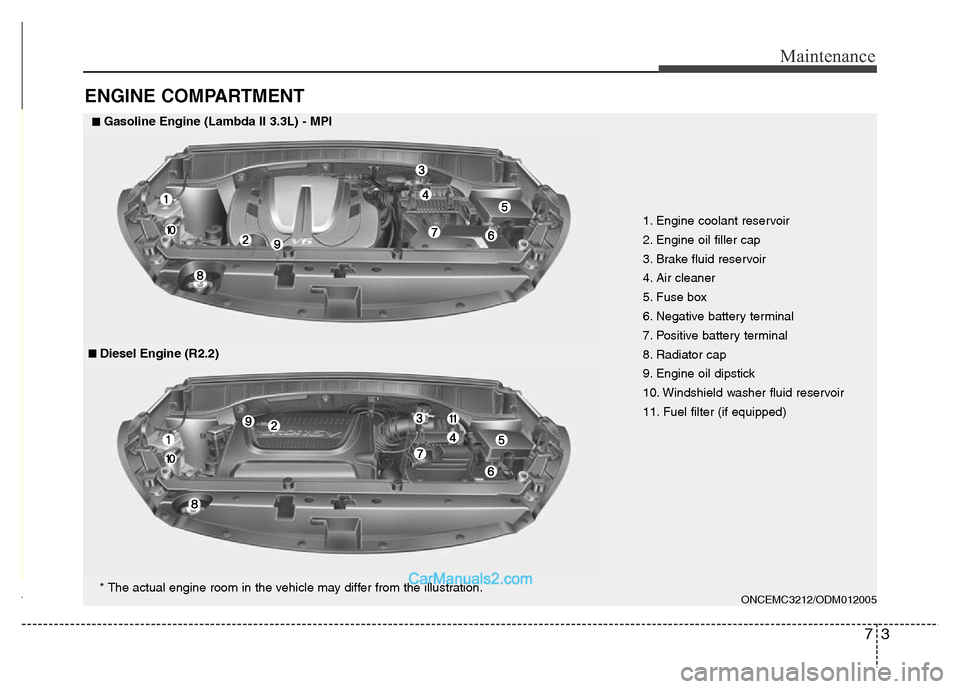
73
Maintenance
ENGINE COMPARTMENT
1. Engine coolant reservoir
2. Engine oil filler cap
3. Brake fluid reservoir
4. Air cleaner
5. Fuse box
6. Negative battery terminal
7. Positive battery terminal
8. Radiator cap
9. Engine oil dipstick
10. Windshield washer fluid reservoir
11. Fuel filter (if equipped)
ONCEMC3212/ODM012005
■Diesel Engine (R2.2)
* The actual engine room in the vehicle may differ from the illustration.
■■Gasoline Engine (Lambda II 3.3L) - MPI
Page 586 of 717
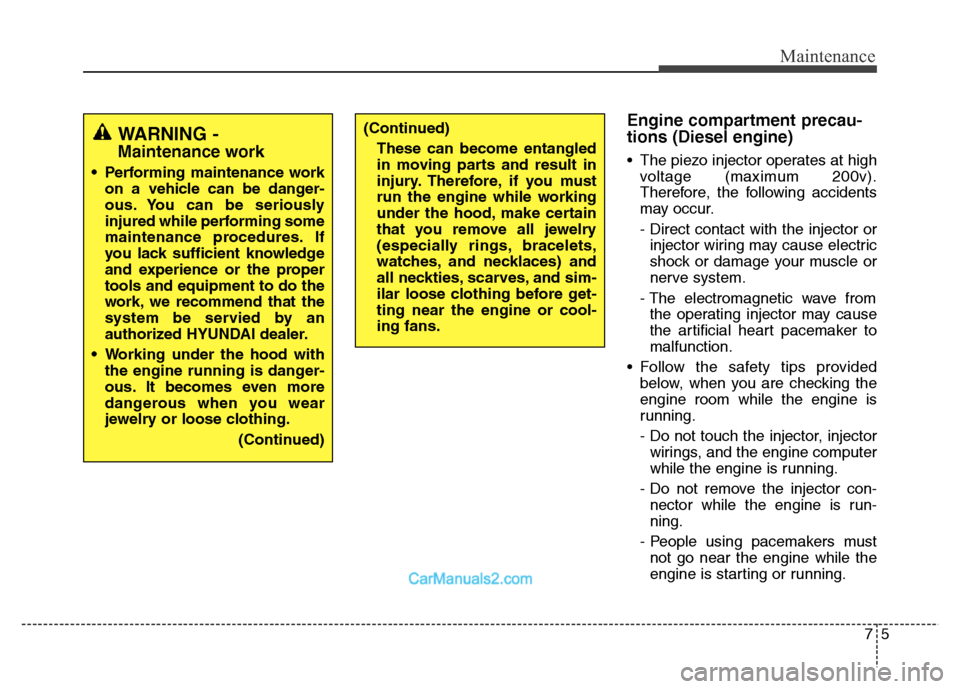
75
Maintenance
Engine compartment precau-
tions (Diesel engine)
• The piezo injector operates at high
voltage (maximum 200v).
Therefore, the following accidents
may occur.
- Direct contact with the injector or
injector wiring may cause electric
shock or damage your muscle or
nerve system.
- The electromagnetic wave from
the operating injector may cause
the artificial heart pacemaker to
malfunction.
• Follow the safety tips provided
below, when you are checking the
engine room while the engine is
running.
- Do not touch the injector, injector
wirings, and the engine computer
while the engine is running.
- Do not remove the injector con-
nector while the engine is run-
ning.
- People using pacemakers must
not go near the engine while the
engine is starting or running.
WARNING -
Maintenance work
• Performing maintenance work
on a vehicle can be danger-
ous. You can be seriously
injured while performing some
maintenance procedures. If
you lack sufficient knowledge
and experience or the proper
tools and equipment to do the
work, we recommend that the
system be servied by an
authorized HYUNDAI dealer.
• Working under the hood with
the engine running is danger-
ous. It becomes even more
dangerous when you wear
jewelry or loose clothing.
(Continued)
(Continued)
These can become entangled
in moving parts and result in
injury. Therefore, if you must
run the engine while working
under the hood, make certain
that you remove all jewelry
(especially rings, bracelets,
watches, and necklaces) and
all neckties, scarves, and sim-
ilar loose clothing before get-
ting near the engine or cool-
ing fans.